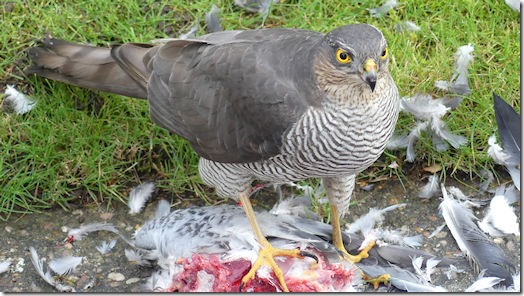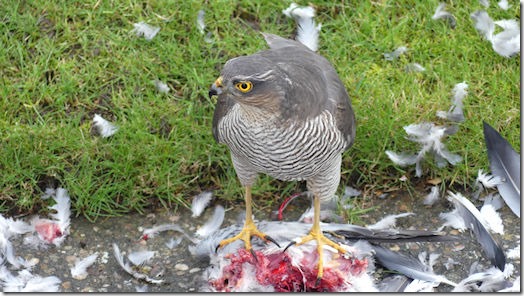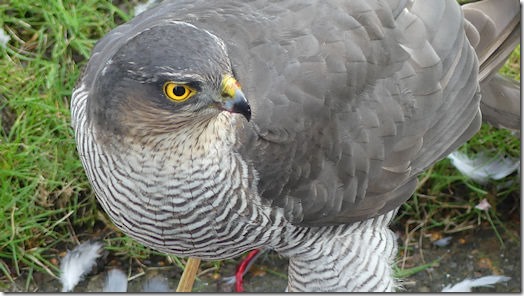It’s late spring 2023 and this article is showing increased interest again. We haven’t got anywhere near last year’s temperatures yet, and until May there was no real need to water, since it had been quite wet. As of late May, though, I have commenced regular watering and feeding – the first feed, in particular, seemed to prompt my tree to throw out a lot of new leaves.
The following is the original article… but remember: water, water, water. And feed!

Back in 2014, when I originally wrote this, our Birch tree suddenly began to produce a lot of yellow leaves in mid-June. After a lot of research I managed to figure out the possible causes and the remedies. That was the purpose of the original article.
However, 2018 threw up a new issue. It turned out to be the hottest year on record, but even before we found that out people will remember how hot it was, and for how long it stayed like that. My tree once again began to show a few sprays of yellow fairly early in the season.
The article becomes popular each year, firstly in late Spring and early Summer, then again later in the season closer to Autumn.
In 2014, I identified the following as likely causes of premature yellowing:
- nutrient deficiency
- iron deficiency
- manganese deficiency
After the 2018 heatwave, I further identified lack of water as a major factor. With hindsight, it may have also been a factor in that 2014 season, but nothing compared with 2018 for prolonged heat and lack of rain.
When I first experienced yellowing back in 2014, I initially thought my tree was dying. Googling for an answer was pretty much useless, because most of the technical advice is American and focuses on the Bronze Birch Borer (a beetle that feeds on white birches), which isn’t known outside of North America. But somewhere in among the advice, I came across a simple comment – and I don’t recall where I saw it now – that made a lot more sense.
In a nutshell, premature yellowing/leaf drop can be caused by nutrient and iron deficiencies in the soil. This comes about over a period of time as fallen leaves are swept up each year and sent to the tip, so none of the nutrients are returned to the soil. Consequently, the soil becomes depleted of them.
Birches are ericaceous – lime-hating – plants, and prefer a slightly acidic soil. As such, you need to feed them using ericaceous fertiliser. I first used Miracle-Gro solid fertiliser, intended for Azaleas and Rhododendrons (also lime-hating), but a couple of years later switched to Doff liquid feed so I could use it in my Access Irrigation Static Dilutor. I also got hold of some Maxicrop Seaweed Extract, which is also liquid, and watered that in at the same time.My original problem showed itself as canary-yellow leaves, either in sprays, or randomly dotted throughout the canopy. On closer inspection, some of the leaves looked like those in the photograph here.
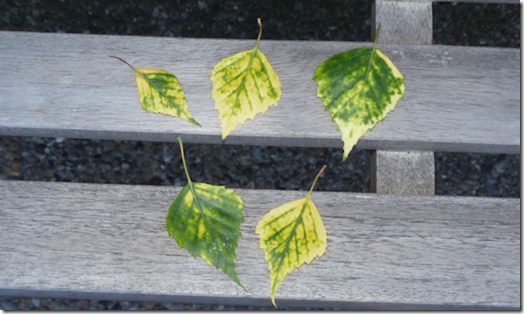
This is known as chlorosis. Leaves are usually green because they contain chlorophyll – and chlorophyll is green. Chlorophyll is what allows plants to convert light energy into sugars that they can use as food through the process called photosynthesis. Plants use iron to produce chlorophyll, so if there isn’t enough iron in the soil the tree can’t make enough chlorophyll, and you get yellowed leaves. The tree compensates for being hungry (if it hasn’t got chlorophyll it can’t make food for energy) by going into shutdown and shedding those leaves. And you may also find that new leaves are small and misshapen when chlorosis is the issue.
You can easily treat chlorosis using sequestered iron (or seaweed extract). Being ‘sequestered’, the tree can suck the iron up and use it right away. A longer term solution is to use iron sulphate lawn feed, which also slightly acidifies the soil over time.
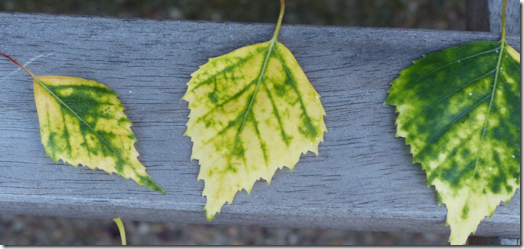
I also bought some manganese to water in the first time, but I am not sure how relevant that was. I used it for a couple of seasons, but stopped. Each year, I simply feed the tree once or twice a month between March and September using fertiliser and seaweed extract.
Note that none of these problems are confined to Silver Birches. All trees and plants can be affected by nutrient deficiencies, and you simply have to deal with the problem using the appropriate, easily purchased treatments.
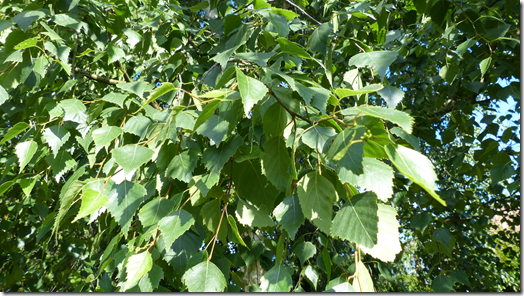
In that first season, a single application of fertiliser stopped the leaf drop almost immediately. Once the already-yellow leaves had fallen, the tree remained green until Autumn, and even threw out some large new leaves and fat catkins. It obviously liked what I had done to it, and I continued doing it from June until September every few weeks.
Everything was fine until the hot summer of 2018. You might recall that the prolonged heatwave began quite early, and by the end of June I was again noticing a few sprays of yellow. I wasn’t a nutrient issue this time – I was feeding the tree regularly – but I’d already guessed the hot weather might have something to do with it, and a bit more research showed that heat stress in trees is a real issue, and Birches are highly susceptible to it.
It turns out that lack of moisture in the ground combined with prolonged high air temperatures causes trees – and especially Birches – to become stressed, which again triggers them to go into emergency shutdown by shedding leaves.
My research provided two options for getting water down to the roots (which fortunately, in the case of Birches, is quite shallow). One involved hammering at least half a dozen hollow spikes into the ground around the tree and dripping water directly down to them. I decided against that on the basis that a) the ground was already as hard as iron plate, b) anything which sounds so simple (i.e. hammering a hollow plastic spike into the soil) was going to turn into a nightmare of split plastic, only being able to get part way down, and discovering chunks of bedrock I didn’t know were there, and c) having these things poking out of the lawn would look bloody awful even if I got them in (and even worse if they only went in part-way). The easier option was to commence heavy-watering immediately – basically, to run the sprinklers for hours at a time every night.
That method fixed the problem in less than a week.
With hindsight, it is quite possible that lack of moisture was a contributing factor back in 2014, and my feeding routine would have dealt with that automatically (though I did have chlorosis). But in 2018, it was definitely just the result of too little moisture around the roots.
So, to summarise. If you experience premature leave-yellowing, the very first thing you should do is water like crazy. Don’t worry about over-watering too much – Birches like wet soil, which is why they grow near streams. Just don’t turn your garden into a swamp. While you’re doing that, buy some ericaceous feed and seaweed extract, and get that into your soil as soon as possible (how much depends on how big your tree is).
Can you rescue leaves which have turned yellow?
No, probably not. I suppose that chlorosis could be reversed if you caught it early enough, but if the leaf is dead and the tree has triggered its shedding mechanism, you’re going to lose them.
The important thing is that by feeding and watering the tree you can stop any further yellowing – and believe me, the first time you do it the effects will be quite noticeable within a short time.
Do you have to keep treating the trees?
Yes. If you don’t, the problem just comes back once the tree has used up what you’ve fed it, especially if you bin the leaves again the following autumn. Huge trees will suck up all the nutrients and water, and if you’re raking up and binning the leaves each year (or if the soil is dry and there are no prolonged periods of rain) nothing gets returned to the soil.
How often should you feed?
Treat them once or twice a month from March until September. And water regularly.
Can heat and drought cause them to lose leaves?
Yes. If they are stressed you may get them dropping leaves. In extreme cases the leaves can go brown and the tree can even die. It’s a good idea to water them deeply during hot, dry periods. Once or twice a week should be enough, though more frequently won’t hurt if the dry period is prolonged.
Remember that after a period of drought (or prolonged dry weather) it needs an extended period of rain to wet the soil again, especially deep down. A few heavy downpours won’t do it, and you will still need to help things along.
Will a Birch recover from drought?
It depends on whether the drought killed it or not. A reader wrote to me in 2018, mentioning that his tree had lost its leaves, and I advised that the only thing he could do right then was to feed and water – and hope for the best. He wrote to me in 2019 to tell me the tree had started to rock in the wind, and that a tree surgeon had subsequently declared it dead, and had had to remove it. Apparently, the roots were rotten.
There’s no way of knowing if it was just the drought that did the damage. The tree may have been weakened by not feeding and watering over previous years, and the drought was just the final nail in the coffin. But the 2018 heatwave certainly caused problems.
Is there any other way to deal with the problem?
You have to get nutrients and iron back into the soil. And you need water in order for the roots to be able to access those nutrients. Yes, you could use your own mulch or bought compost, but obviously this is not so attractive in a normal garden (removing it is what got you here in the first place). It would also take longer to have an effect. But it would still work, given time.
When do Birch trees normally start to shed their leaves?
In the Autumn! In the UK this is from around September-October, and the onset varies up and down the country. It often seems triggered by a noticeable drop in night time temperatures. The leaves will begin to fall from that point – very lightly at first, then increasing as the yellowing spreads.
Why do birch trees drop leaves so early?
They don’t. They drop them in Autumn, like all other trees which shed their leaves each year. If yours is turning early, you may have a problem.
How do you apply these treatments?
You make up the required solution as directed on the pack, then water it into the area specified. I use a combined watering/fertilising system, which I have written about separately. However, you can use a watering can and hosepipe/sprinkler as necessary. Note that if the ground is dry, a watering can won’t get the nutrients down to the roots, so a heavy watering is essential.
Why are fallen leaves sticky?
You’ve probably got greenfly! Specifically, the birch aphid, Euceraphis betulae. They feed on the European Birch, Betula pendula, and they increase in number during warm and dry weather. Aphids secrete honeydew as they feed, and that’s the sticky stuff you’re seeing. Apparently, you can get different species of greenfly that feed on specific trees.
You can kill them with a soap/water mixture, though no one has ever been able to tell me precisely how you apply that to a 20 metre high tree. And the same goes for any chemical method relying on direct contact. An alternative solution is to introduce predatory insects – something that eats aphids. The best one is the Ladybird larva, and you can buy them online. There are other predatory insects you can buy, too.
My tree is losing branches and twigs
If the tree is weak then it is understandable that twigs and small branches might fall off. Once they’re stronger this will stop. In any case, if it is windy, a few dead twigs are bound to fall off. It’s just nature – and birches also have a fungus which can cause small twigs to die and fall.
In the Spring, Crows can also be a problem if they’re nesting nearby. They are very, very selective in their choice of twigs for the purpose, and they will tear off dozens until they get the right one. It’s nature, so we don’t worry when they’re using ours for their twigs.
When do birches start to show leaves?
In Spring, obviously, but the precise date varies depending on both the tree and the weather. In 2019, they were about a month earlier than 2018 in the UK. Mine is usually showing leaves sometime during April each year.
I’ve got catkins but no leaves
Someone found the site in April 2018 with that query. You’ll probably find that in a couple of weeks you’ll have lots of leaves. As I have said in this article, I start feeding mine from March onwards. Leaves start sprouting a week or two earlier than my neighbours’ trees, and the foliage on mine is usually much denser. The catkins often come before the leaves.
Are the leaves changing early this year?
This was a generic search term used to find the blog in mid-July 2017. The short answer is no, they are not – not in July in the UK, anyway. They change towards the end of September in the UK.
Do Weeping Silver Birches lose their leaves in Autumn?
Yes.
When do Silver Birch leaves go all brown?
They don’t. The leaves should go yellow and fall off in the autumn.
I had quite a few visitors from this search term in 2018, and when I looked it up it seems that extreme cases of chlorosis and heat stress can result in leaves turning brown (see this supplementary article). It could also be a disease or infestation which you could treat, but the tree itself might also be dead – especially if it has been having any of the problems I mentioned above over previous years. Best to call in the experts.
Does this advice only apply to Silver Birch trees?
No. Chlorosis can affect many plants, and lack of nutrients is a universal issue. You might need a different fertiliser to address any nutrient problem, but iron will likely fix chlorosis. Lack of water can kill virtually any plant.


